Palin (throne)
Palin (Burmese: ပလ္လင်; from Pali: pallaṅka, lit. "couch" or "sofa") refers to one of six types of thrones recognized in traditional Burmese scholarship. The palin is a major symbol of the Burmese monarchy and features prominently in Burmese architecture and Burmese Buddhist iconography. The palin is featured on the seal of Myanmar's Ministry of Religious Affairs and Culture.
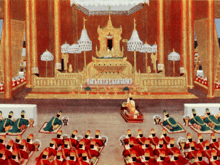
Types of palin
Traditional Burmese scholarship recognizes six types of thrones, namely:
- Aparājitapallaṅka (အပရာဇိတပလ္လင်) - the Buddha's throne
- Kamalāsanapallaṅka (ကမလာသနပလ္လင်) - Brahma's throne
- Dibbāsanapallaṅka (ဒိဗ္ဗာသနပလ္လင်) - nat's throne
- Rājapallaṅka (ရာဇပလ္လင်) - monarch's throne
- Dhammāsanapallaṅka (ဓမ္မာသနပလ္လင်) - Buddhist monk's throne
- Aṭṭakaraṇapallaṅka (အဋ္ဋကရဏပလ္လင်) - judge's throne
Usage by Burmese monarchs
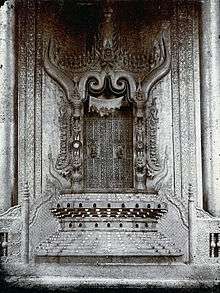
In pre-colonial times, the rājapallaṅka (Burmese yazapalin) seated the sovereign and his main consort. Traditionally, Burmese palaces possessed eight types of thrones, housed in nine palace halls, leading to the Burmese adage, "eight thrones, 9 palace halls" (ပလ္လင်ရှစ်ခန်း ရွှေနန်းကိုးဆောင်).[1]
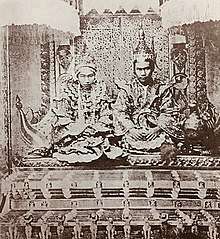
The thrones were carved of wood, specifically by hereditary palace carpenters.[2] An auspicious time was chosen by astrologers to commence operations, and construction of these thrones was heralded by a royal ceremony to propitiate spirits.[2] The thrones were simultaneously constructed according to a prescribed list of requirements, coated with resin, and decorated with gold leaf and glass mosaic.[2]
The most important throne was the "Lion Throne" (Sīhāsanapallaṅka), which had a replica in the Hluttaw as well.[2]
The thrones used different prescribed motifs and designs, types of wood, and were allocated to specific halls in the royal palace.[3] The thrones were also grouped by height, as follows:
- Mahāpallaṅka (မဟာပလ္လင်) - 24 feet (7.3 m)
- Majjhimapallaṅka (မဇ္စျိမပလ္လင်) - 12 feet (3.7 m)
- Cuḷapallaṅka (စူဠပလ္လင်) - 6 feet (1.8 m)
Below is a list of these eight types of thrones:
| No. | Name (Pali) | Name (Burmese) | Primary Motif | Type of Wood | Location(s) in Palace | photo |
|---|---|---|---|---|---|---|
| 1 | Sīhāsanapallaṅka | သီဟာသနပလ္လင် | Chinthe (lion) | Gmelina arborea | Royal Audience Hall; |  |
| 2 | Bhamarāsanapallaṅka | ဘမယာသနပလ္လင် | Bumblebee | Cinnamomum tamala | Glass Palace | 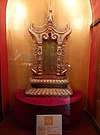 |
| 3 | Padumāsanapallaṅka | ပဒုမ္မာသနပလ္လင် | Lotus | Artocarpus heterophyllus | Western Audience Hall | 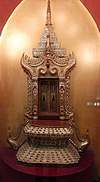 |
| 4 | Haṃsāsanapallaṅka | ဟံသာသနပလ္လင် | Hamsa (bird) | Hopea odorata | Eastern Hall of Victory | 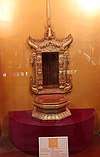 |
| 5 | Gajāsanapallaṅka | ဂဇာသနပလ္လင် | Elephant | Magnolia champaca | Byedaik (Privy Council) | 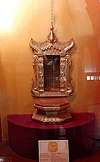 |
| 6 | Saṅkhāsanapallaṅka | သင်္ခါသနပလ္လင် | Conch | Mangifera indica | Regalia Hall | 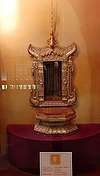 |
| 7 | Migāsanapallaṅka | မိဂါသနပလ္လင် | Deer | Ficus glomerata | Southern Gatehouse Hall | 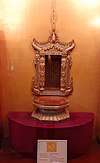 |
| 8 | Mayurāsanapallaṅka | မယုရာသနပလ္လင် | Peacock | Butea monosperma | Northern Gatehouse Hall | 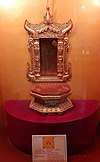 |
Usage in Buddhism
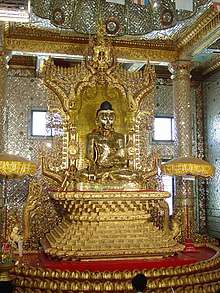
The palin is also used to seat images and statues of the Buddha, variously called gaw palin (ဂေါ့ပလ္လင်), phaya palin (ဘုရားပလ္လင်) or samakhan (စမ္မခဏ်), from the Pali term sammakhaṇḍa. This palin is a feature of many Buddhist household shrines in Burma.
References
- "ယဉ်ကျေးမှု ထုံးဓလေ့ဟောင်း တို့နိုင်ငံသားတို့မမေ့ကောင်း". Myanmar News Agency.
- Thant, Yi Yi (December 1960). "The Thrones of the Burmese Kings" (PDF). Journal of Burma Research Society. 43: 97–123.
- Tha, Maung (2016-11-15). "ပလ္လင်ရှစ်ခန်း၊ ရွှေနန်းကိုးဆောင်". Ministry of Information.